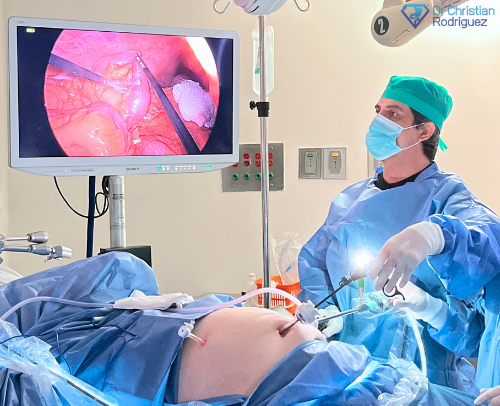Duodenal switch surgery, also known as biliopancreatic diversion with duodenal switch (BPD/DS), is a weight loss procedure that combines two strategies to achieve weight loss. The surgery includes reshaping the stomach into a smaller, sleeve-like pouch to restrict food intake and rerouting the small intestine to limit the absorption of calories and nutrients. This method helps patients manage their weight by controlling how much they eat and how efficiently they absorb nutrients. The surgery provides an effective way to shed pounds, leading to greater long-term results. On average, patients lose 78% extra body weight in the first year.
Dr. Christian Rodriguez is the #1 Duodenal Switch Surgeon in the world Working exclusively with Mexico Bariatric Center®
How Duodenal Switch Works
The procedure consists of two main parts:
- Sleeve Gastrectomy: A portion of the stomach is removed and reshaped into a smaller, sleeve-like structure. This reduces the amount of food a person can consume at one time.
- Intestinal Bypass: The duodenum, which is the initial segment of the small intestine, is separated immediately after the stomach. The lower portion of the small intestine is then reattached to the new stomach pouch, bypassing a large section of the small intestine. This alteration decreases the absorption of calories and nutrients.
The combination of restrictive and malabsorptive features helps with weight loss by curbing food intake and limiting calorie absorption. This approach also influences hunger and metabolic hormones, extending the feeling of being satisfied for longer periods.
Single Loop Duodenal Switch Surgery (SADI-S)
The Single-Anastomosis Duodeno-Ileal Bypass with Sleeve Gastrectomy (SADI-S) is the modified version of the duodenal switch but with a simpler approach. In this surgery, the stomach is made smaller, like in a sleeve gastrectomy, and the first part of the small intestine (the duodenum) is cut just after the stomach. The lower part of the small intestine (the ileum) is then attached directly to the smaller stomach, skipping most of the small intestine.
SADI-S offers similar benefits to the duodenal switch, such as limiting food intake and nutrient absorption, but it’s simpler because it involves only one intestinal connection. This surgery may result in a shorter surgery and a faster recovery time.
Learn more about the differences between Duodenal Switch and Single-Loop Duodenal Switch (SADI-S)


Am I a Candidate for Duodenal Switch?
- Patients need to have a body mass index of 45 or more
- Patients with a BMI of 40 can be candidates for the duodenal switch as long as they have co-morbidities, including type 2 diabetes, hypertension, high blood pressure, or other diseases

HW: 397 lbs
SW: 347 lbs
CW: 186 lbs
Duodenal Switch Weight Loss Timeline

Patients can expect to lose about 78% of their excess body weight due to the combined effects of the two weight-loss components. In the first three months following duodenal switch surgery, patients typically lose between 1/2 pound and 1 pound per day.
- 3-6 Months: Weight loss will continue steadily as patients adjust to their new diet and lifestyle changes. They can expect to lose on average 35% excess weight . Having stalls or not losing weight during the first three months is completely normal because your body changes.
- 6-12 Months: During this period, majority of patients will lose the most weight—roughly 55% excess weight .
- 12-18 Months: Weight loss will stabilize around this time and patients will have lost 75-80% excess weight .
- 2-5 Years: Patients must maintain their weight loss by following the post-op diet, being more active, and taking bariatric vitamins. They can expect to lose up to 82% excess weight .
**Please keep in mind that everyone’s body responds differently—some may experience quicker results than others. Don’t be discouraged.
Pros and Cons of Duodenal Switch
Pros
- Reversible procedure: The malabsorptive component can be reversed, functioning independently as a gastric sleeve
- Significant weight loss: The duodenal switch leads to one of the highest percentages of excess weight loss among bariatric surgeries
- Improve health: Many obesity-related health conditions such as type 2 diabetes, hypertension, PCOS and sleep apnea improve or resolve after surgery
- Sustained weight loss: Patients often maintain their weight loss over the long term
Cons
- Vitamin Deficiencies: The malabsorptive nature of the surgery can lead to deficiencies in vitamins and minerals, requiring lifelong supplements and monitoring
- Risk of gallstones: Gallstones are a frequent risk factor associated with post-operative weight loss
- Complexity: The duodenal switch is a complex surgery, which may require a longer hospital stay and recovery time compared to other bariatric procedures
Duodenal Switch in Mexico
Starting at $6,995 $5,995
Experience world-class bariatric care with Dr. Christian Rodriguez Lopez in Tijuana, Mexico. Enjoy our all-inclusive package for the duodenal switch procedure, starting at just $5,995 USD —significantly more affordable than the $20,000 price in the States. Dr. Rodriguez is a leading expert in the duodenal switch and SADI-S procedure.
Mexico has become a premier destination for weight loss surgery, drawing international patients who seek top-notch care at a fraction of the cost. Dr. Rodriguez collaborates with the highly regarded Mexico Bariatric Center , which offers skilled surgeons and state-of-the-art facilities. We recommend patients considering surgery in Mexico conduct thorough research to choose a reputable medical center and an experienced surgeon.
Related Articles:


